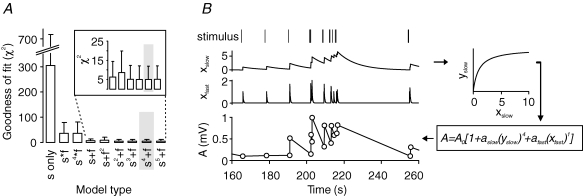Figure 2. Model of mossy fibre STP.
A, to identify the most reliable model of mossy fibre STP, we tested several different additive and multiplicative interactions of slow and fast facilitatory processes for goodness of fit. The combination ‘s4+f’ yielded the lowest χ2 values and was therefore chosen for all further analysis (highlighted in grey; n = 12 experiments). B, in our chosen model, a random stimulus train (top) is translated into two dynamical variables, xslow and xfast, via first-order kinetics. To account for saturation of facilitatory amplitudes, xslow is inserted into a nonlinearity xslow→yslow=G(xslow). Powers of yslow and xfast are then scaled by amplitudes aslow and afast, respectively. Finally, the two components are added. Incorporating the baseline amplitude A0, we obtained predictions for the fEPSP amplitudes A.

